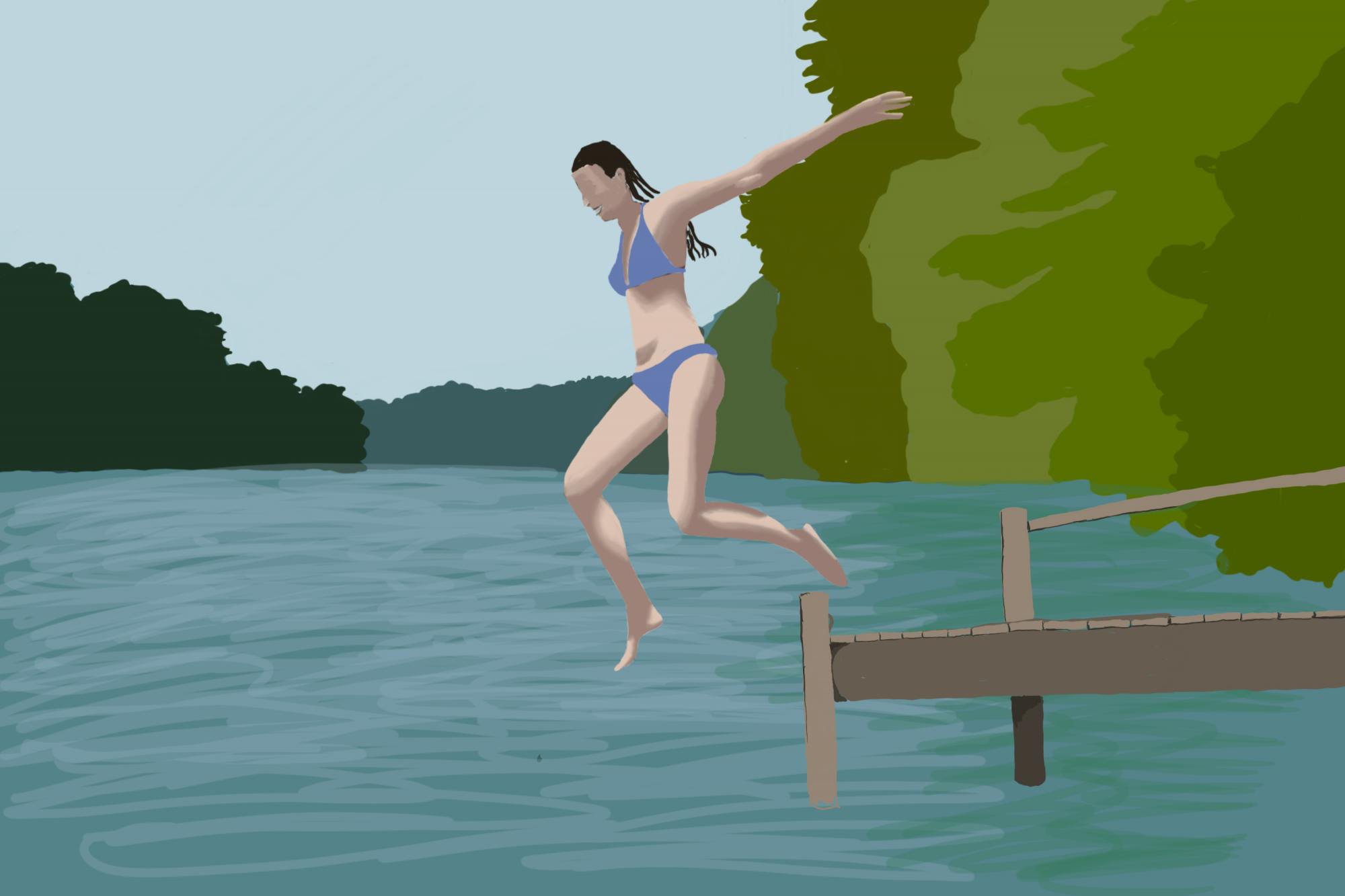A few months ago, I stumbled across an internet phenomenon touting the benefits of ice-water dips. They cited mental benefits to cold-water plunging in ice baths or frozen lakes, such as the rush of adrenaline that comes with dunking yourself in freezing water. It wasn’t until my return to campus this winter that I saw this dipping in action, as I watched the few and the brave descend into the icy Connecticut. Breaking through inches of snow and ice, the students I witnessed were eager to participate in what many might consider torture.
With the arrival of spring, the river is no longer frozen, but the water temperature still has not breached 40 degrees Fahrenheit. Every day, many seniors face off against this frigid water in a tradition known as “The Daily Dip.” While the origins of this tradition are unclear, dipping has become a daily ritual for many.
According to Sanne Schouten ’23, seniors have created a GroupMe chat where participants post proof of their daily dip. Lily Maechling ’23 said that there are “about 150” seniors in this group.
“Most people post a selfie after they dip,” Maechling said. She added that some dippers captioned their selfies. According to Maechling, a student posted a photo of an Aquinas House priest and member of the local Hanover community submerging himself on Easter day and captioned it.
“[The caption read], ‘Watch me dip, watch me nae nae … He has risen’” Maechling said.
This shows that dipping isn’t just for Dartmouth seniors, but also Hanover community members. Underclassmen also flock to the river for a cold shock to the nervous system.
I have seen firsthand that the challenge breeds a sense of camaraderie among dippers. On a particularly gray and windy Friday morning, I accompanied Tea Wallmark ’25 to dip in the river. As we walked down old Tuck Drive, a brisk wind whipping around the bend, we passed Schouten on her walk up from her dip. Although I did not know I would be interviewing her later, she smiled at us with the knowing eyes of a fellow dipper.
Accompanying Wallmark and her friends to the river, there were other students braving the windy conditions. Emma Bonz ’25 brought her mother Mandy to dip with her, the two bracing against the chill in sweatpants.
“Well I’ve been telling my mom about how I like to come dip in the river, and she wanted to come and see it!” Bonz said.
“I taught her how to do things like this,” Mandy Bonz quipped. “I think it’s the best thing that happens at Dartmouth.”
So why are students so committed to the dip? Many participants cite the mental clarity and alertness they feel after jumping in the Connecticut River’s icy waters. According to The New York Times, researchers suspect that dipping in frigid waters has mental health benefits. Immersing oneself in icy waters triggers the release of stress hormones and increases brain chemicals such as dopamine that regulate mood.
“Reading about [cold-water plunges], they compare it with caffeine or cocaine,” Schouten said, adding that she has not felt the need to start her days with coffee this term because her morning cold-water plunge wakes her up.
“I feel like I have more energy in the mornings knowing that I’m going to come do this, and I feel like it's helping my mental state. Wallmark said. “It's making me less stressed, and it centers me and puts me in the present moment.”
According to Maechling, the daily dip challenge elicits a range of conflicting emotions.
“Before you get in the water, there’s a bit of existential dread. You’re trying not to get in. But also, you’re trying to get it over with.”
But after?
“Honestly, you feel energized,” Maechling continued. “ … the best part of the dip, is how you feel afterwards. You feel ready to take on the day. Except then I often take a [long],hot shower.”
Wallmark began dipping over the winter term and said she is familiar with drilling holes in the ice to jump in having lived in Sweden. At their best, her daily dips were “serene,” with snow coming down on the river around her. At their worst, she had to break through a new layer of ice with a chair.
“I lost the chair in the water, so I had to go back in after going in and my feet have never been that cold ever,” Wallmark recounted.
“I don’t have a lot of commitments senior spring. I think my most pressing commitment is the dip,” Maechling said.
Schouten asked me at the end of our conversation, “Have you dipped?”
After telling myself I would dip all winter long, I finally took the plunge at the start of this term. As I walked with my friends down to the Ledyard Clubhouse, we seriously regretted choosing the slope instead of the stairs. My Reeboks oscillated between losing traction on thick chunks of ice and descending ankle-deep into patches of snow.
I braced myself for the cold at the edge of the water. I waded up into my waist, already losing feeling in my legs. In a split second, I fell back, letting my head fall fully under the water. According to Maechling, fully submerging is crucial to the integrity of the dip.
“I believe it’s only a dip if you’re jumping in, not wading in,” said Maechling. Upon further questioning, she decided that as long as your head goes under, it counts.
As I dashed out of the water, I felt that rush of adrenaline so many described. I dipped at 9:30 a.m. and left the river feeling energized and alert. Although I might not join daily, I’ll certainly be dipping again this term.




